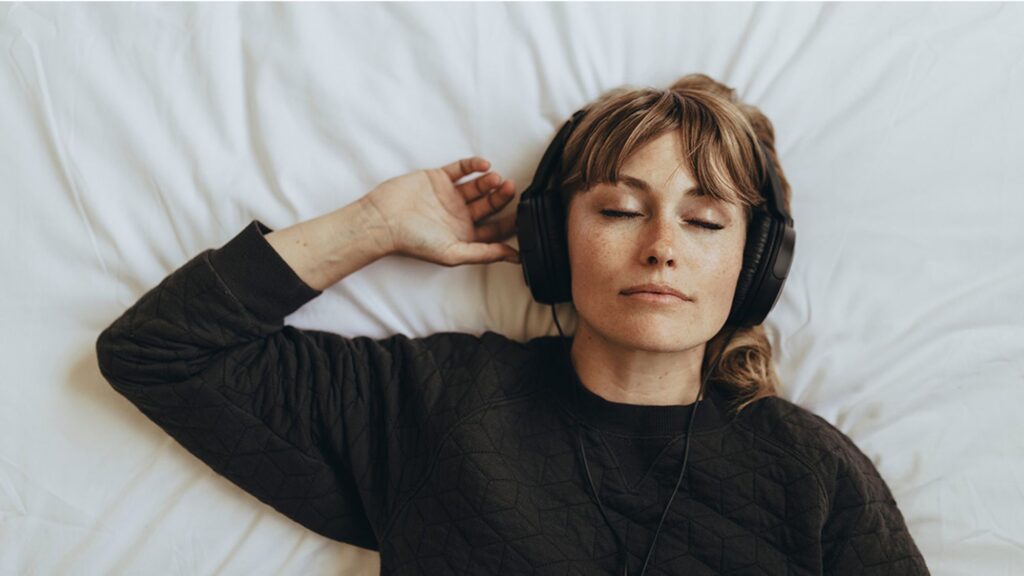
Have you ever been sitting in the chair at the hair salon and noticed a tingling, relaxing feeling when your stylist combed through your hair? What about a deep sense of relaxation from hearing someone whisper? Well, that experience has a name: ASMR. If you have experienced this delightful, goosebumps-sensation feeling — you are part of the 20 percent of the population who experiences the phenomenon, which is brought on by audio or visual triggers. How does ASMR help you sleep? Keep reading to learn more.
Long Story Short
- ASMR is the phenomenon behind what many describe as a pleasurable, tingling feeling in the scalp that makes its way down the back.
- ASMR can be triggered by quiet noises such as whispering, pages turning, or scratching.
- ASMR can be an effective way to calm and relax the body and aid in restful sleep for those who experience it.
What Is ASMR?
ASMR, which stands for Autonomous Sensory Meridian Response, is a deeply relaxing sensory phenomenon that happens in response to certain visual or auditory stimuli, such as tapping or speaking softly. It typically begins in the scalp and then works its way through the rest of the body.
While research on ASMR is still building, studies that have taken place so far have found promising results on its ability to help you sleep restfully. A 2018 study found ASMR was associated with a reduced heart rate — plus, the technique may have therapeutic benefits for both mental and physical health.
What Triggers ASMR?
For different people, different stimuli produce a calming effect. It can range from gentle whispering, turning pages of a book, crisp sounds, tapping, physical touch like hair brushing, and much more.
Sleepopolis spoke with Craig Richard Ph.D., an ASMR expert and founder of the ASMR University. He coordinates the largest database about ASMR and co-authored the first peer-reviewed publication of the first ASMR brain scan study.
“ASMR is often triggered for someone when a kind person is giving them positive, gentle, personal attention. This kind person is usually talking softly, moving gently, and creating light sounds — these stimuli are often called ‘ASMR triggers,’” he explains. This soft-spoken person may be someone in real life, in a video online, on a podcast, or on a TV show.
“One example that many people can relate to is Bob Ross, from “The Joy of Painting.” His personality, kindness, soft voice, and gentle painting sounds have induced ASMR in many viewers,” Richard says.
How Does ASMR Work?
Research into how ASMR works is still new. In fact, people who experienced this tingling, pleasurable feeling only first started communicating about it around 2010 in online communities.
One study with 290 participants theorized that individuals who experience ASMR might have higher levels of “openness-to-experience.”
A 2019 study about the perceptual phenomenon found another possibility — that the ASMR experience was associated with reduced functional connectivity, which is a way to examine how different regions of the brain interact with one another. In a nutshell, this could mean people who experience ASMR are wired differently.
ASMR and Sleep
From blocking out background noise to soothing anxiety, people across the internet talk about the many benefits of using ASMR videos, podcasts, and playlists to catch some restful ZzZz’s.
“ASMR is probably due to an increased release of oxytocin, a brain chemical known to be stimulated by positive personal attention and resulting in feelings of comfort and relaxation,” says Richard.
How to Use ASMR for Sleep
- First, make sure ASMR works for you— right now, Richard estimates that about 20 percent of the population experiences it, so try out a few videos or playlists before you jump to any conclusions.
- Find a creator or type of ASMR that works for you. You can search for videos or podcasts with a wide variety of ASMR sounds, including whispering, crinkling, typing, blowing, and more.
- Choose a relaxing environment, like your bed, to soak in ASMR-triggering sights and sounds.
- Combine AMSR with a consistent bedtime routine and good sleep hygiene, which includes keeping your sleep space cool and quiet.
- If you’re listening to ASMR sounds on an app as you try to fall asleep, make sure it doesn’t roll right into any loud or jarring music — going from whispering to Guns N’ Roses is bound to get your adrenaline pumping!
Other Sounds for Sleep
Don’t forget about white noise, green noise, brown noise, and other sounds that may help some get a good night’s rest, depending on the person. Think of brown noise as those deeper sounds that remind you of being mid-flight on an airplane. Green noise is a frequency of white noise, but with nature tones — imagine hearing waves on the beach.
Experts point to one benefit of static color sounds: They don’t trigger memories or emotional responses. Static sounds, like white and brown noise, can help people turn off the chatter going on in their minds.
Other ASMR Benefits
Richard points to the very first peer-reviewed study on ASMR, published in 2015, which found
ASMR is not only helpful for reducing stress and increasing sleep, but it may also be helpful for pain. Researchers discovered that 42 percent of participants with chronic pain believed that watching ASMR videos had an effect on their symptoms. The benefits don’t stop there — Richard says additional reported benefits of ASMR include:
- Improved mood
- Decreased depression
- Improved focus while studying
- A reduction in heart rate and blood pressure, according to some studies
- Chronic pain
- Depression
The Last Word From Sleepopolis
While there’s plenty to be still to be discovered about ASMR and its benefits, there’s already a lot of promising data out there. The good news is, there’s an abundance of ASMR videos online, so it’s essentially a free sleep resource for those who benefit from it.
FAQs
Q: Is it healthy to sleep with ASMR?
A: According to experts, yes! One study points to ASMR being associated with reduced heart rate. Less stress is always a good thing!
Q: What is the best ASMR to fall asleep to?
A: This completely depends on the type of person and what triggers relaxation for them. The best way to find this out is to search for ASMR videos or podcasts and see what you enjoy.
Q: What does ASMR stand for?
A: Autonomous sensory meridian response.
Sources
Poerio GL, Blakey E, Hostler TJ, Veltri T. More than a feeling: Autonomous sensory meridian response (ASMR) is characterized by reliable changes in affect and physiology. PLoS One. 2018 Jun 20;13(6):e0196645. doi: 10.1371/journal.pone.0196645. PMID: 29924796; PMCID: PMC6010208.
Untangling the tingle: Investigating the association between the Autonomous Sensory Meridian Response (ASMR), neuroticism, and trait & state anxiety Charlotte M. Eid , Colin Hamilton ,Joanna M. H. Greer, Published: February 2, 2022, doi:10.1371/journal.pone.0262668
Fredborg B, Clark J, Smith SD. An Examination of Personality Traits Associated with Autonomous Sensory Meridian Response (ASMR). Front Psychol. 2017 Feb 23;8:247. doi: 10.3389/fpsyg.2017.00247. PMID: 28280478; PMCID: PMC5322228.
Ebben, M. R., Yan, P., & Krieger, A. C. (2021). The effects of white noise on sleep and duration in individuals living in a high noise environment in New York City. Sleep medicine, 83, 256–259. https://doi.org/10.1016/j.sleep.2021.03.031
Smith SD, Fredborg BK, Kornelsen J. Atypical Functional Connectivity Associated with Autonomous Sensory Meridian Response: An Examination of Five Resting-State Networks. Brain Connect. 2019 Jul;9(6):508-518. doi: 10.1089/brain.2018.0618. Epub 2019 May 7. PMID: 30931592; PMCID: PMC6648236.
Lochte BC, Guillory SA, Richard CAH, Kelley WM. An fMRI investigation of the neural correlates underlying the autonomous sensory meridian response (ASMR). Bioimpacts. 2018;8(4):295-304. doi: 10.15171/bi.2018.32. Epub 2018 Sep 23. PMID: 30397584; PMCID: PMC6209833.
Richard, Craig. Ph.D., Founder of ASMR University, personal interview. June 5, 2024.



























